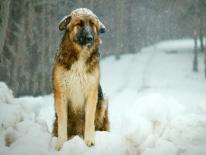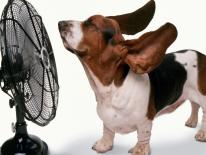

The District of Columbia is unique in that we are fortunate enough to experience four distinct seasons throughout the year. Spring and fall in DC can be mild and pleasant but the winter and summer months can be a time of extreme temperatures. DC Health’s Animal Services Program urges residents to have a heart and allow pets indoors during bouts of harsh weather. In the District of Columbia it is unlawful for owners to leave their pets outdoors during periods of extreme weather without human accompaniment or adequate shelter for more than 15 minutes. “Extreme weather" is defined as temperatures below 32 degrees Fahrenheit or above 90 degrees Fahrenheit.
Below you will find tips to help keep your pets safe year round. Let’s work together to ensure all animals in the District remain healthy and safe during times of cold and heat. If you observe a pet being improperly maintained during extreme weather or witness any animal emergency, please contact DC Animal Care and Control at (202) 888-PETS (7387) or at BVSPCA DC Animal Control & Services. Take note of the date, time, exact location and the type of animal(s) involved. Be prepared to give as many details as possible regarding the situation.
Caring for Pets in Cold Weather:
- Provide adequate shelter during the winter months. "Adequate shelter" means shelter that is safe and protects your pet from injury, rain, sleet, snow, hail, the adverse effects of heat or cold, and physical suffering. The shelter should be large enough to allow your pet to stand and turn in a comfortable manner, but small enough to retain body heat.
- When the temperature is at or below 40 degrees Fahrenheit, make sure your pet has access to a properly winterized shelter. Shelter must be of sound construction, with entrance covered by a flexible wind-proofing material or self-closing door. Dry bedding should be available inside and the shelter should be elevated at least 4 inches off the ground. Dry bedding consist of an insulating material that does not retain moisture, such as straw. Bedding should be of a sufficient depth allowing the dog to burrow for warmth.
- If it’s too cold outside for you, it’s too cold for your pets. Keep pets indoors during periods of extreme cold. Cold temperatures come every year like clockwork, so please plan ahead. Designate and clear an area inside your home to accommodate your pets during cold weather.
- Cold weather can be particularly harsh for shorthaired pets. When taken out for exercise consider providing a sweater for warmth.
- Salt and other chemicals used to melt snow and ice can irritate the pads of your pet's feet. Wipe feet with a damp towel to protect pads and prevent your pet from licking chemicals that may irritate their mouth or stomach.
- Keeping warm depletes energy, pets that spend a lot of time outdoors need more food in the winter. Provide your pet with a healthy diet of high quality food.
- Routinely check your pet's water dish to make certain water is fresh and unfrozen. Use plastic food and water bowls rather than metal in low temperatures to prevent your pet's tongue from sticking and freezing to the container.
- Antifreeze has a sweet taste that may attract pets and young children, but make no mistake, it is a deadly poison. Wipe up spills and store antifreeze (and all household chemicals) out of reach. When possible consider using antifreeze made with propylene glycol; if swallowed in small amounts, it will not hurt pets, wildlife, or your family.
- It is not unusual for small animals to seek refuge from the cold under the hoods of cars. Warm engines provide comfort in low temperatures. To avoid injuring any hidden animals, bang on your car's hood to scare them away before starting your engine.
- In the event of a snow emergency, have a plan. Bring pets indoors immediately during storms. All pets should stay inside until the storm has passed. During severe weather lasting for prolonged periods of time make sure to have an adequate supply of pet food and any medications your pet may need. If evacuation is necessary do not leave pets behind. Be sure to secure your pet on leash or in a carrier. Bring copies of vaccination records, licenses, as well as photos of you and your pets for the purpose of establishing ownership should you become separated. Make arrangements to stay with family, friends or a pet friendly hotel outside of the evacuation zone. If you are unable to find suitable accommodations for your pet during an evacuation event, immediately contact DC Animal Care and Control and report the location of your pet to 202-888-PETS (7387). Lastly, pets can sense an owner in distress. Keeping a cool head helps pets to remain calm. A calm demeanor will aid in the prevention of injury or bites to you as well as other people and pets you may encounter during an evacuation event.
Caring for Pets in Hot Weather:
- Every year hundreds of pets die from heat exhaustion as a result of being left in hot vehicles. Never leave your pet unattended in a parked car. Not even with the windows cracked. On a warm day, temperatures inside a vehicle can rise rapidly to dangerous levels causing your pet to suffer irreversible organ damage or die.
- When outdoors provide pets refuge from direct sunlight and heat. Make sure adequate shade is available. Tree shade and tarps are ideal as they do not obstruct air flow. Be aware that on hot days doghouses retain heat and do not provide relief from extreme temperatures.
- Clean, fresh water in a secure, tip proof container should be available at all times. Add ice to the water periodically throughout the day to help keep your pet cool.
- During periods of especially high temperatures pets should be allowed indoors. Plan ahead and designate an area inside your home for your pet to comfortably occupy during bouts of extreme heat.
- Adjust intensity and duration of exercise in accordance with the temperature. On hot days limit exercise to early morning and evening hours. When possible walk pets on grass as asphalt can become very hot and my damage or burn paws.
- Be aware of the signs and symptoms of heat stroke. Seek medical attention immediately if you notice your pet experiencing heavy panting, glazed eyes, a rapid heartbeat, difficulty breathing, excessive thirst, lethargy, fever, dizziness, lack of coordination, profuse salivation, vomiting, a deep red or purple tongue, seizure or unconsciousness.
For more information on how to properly maintain your pet during inclement weather visit the website for The Humane Society of the United States: humanesociety.org


